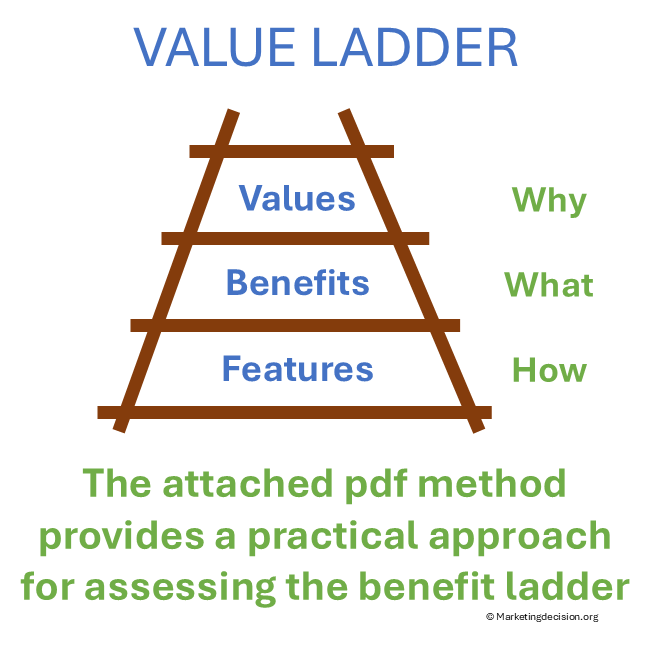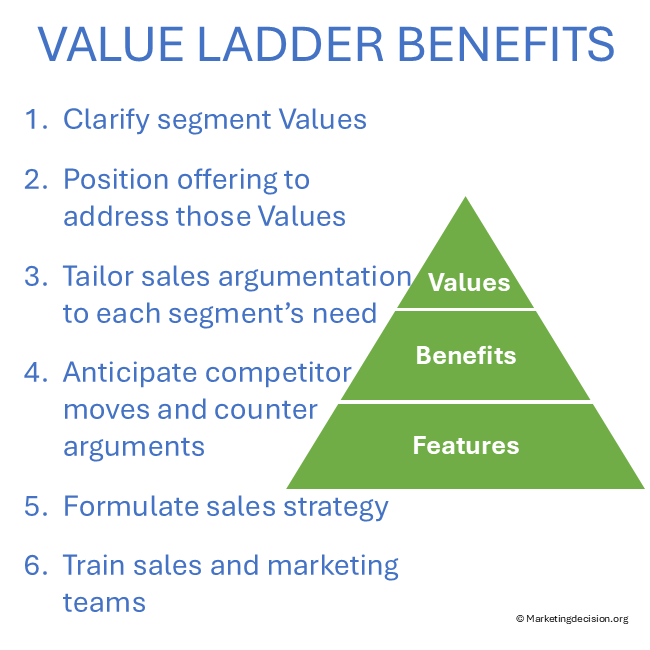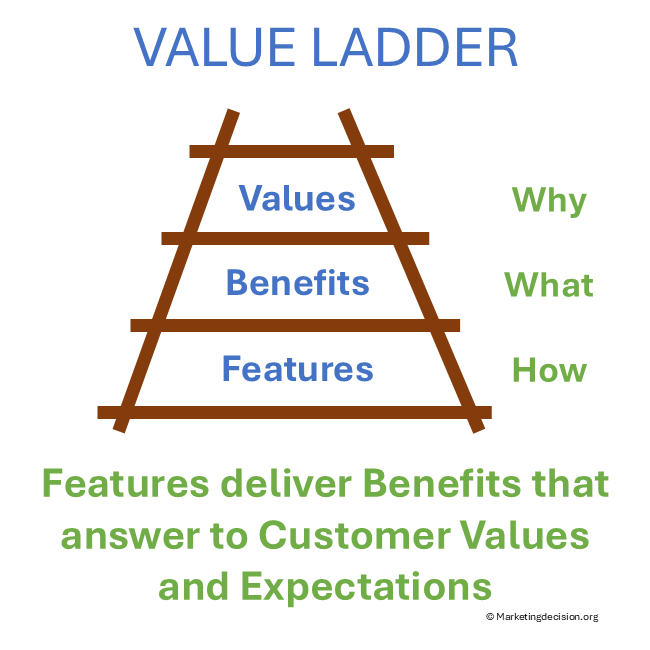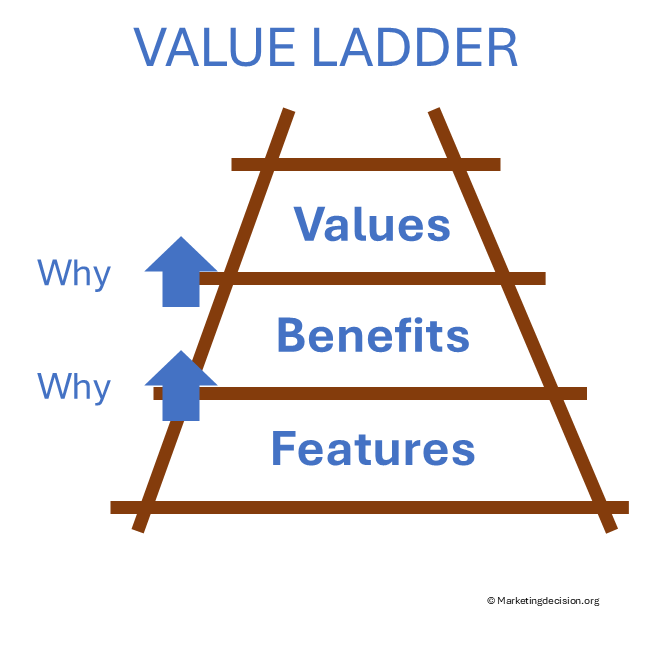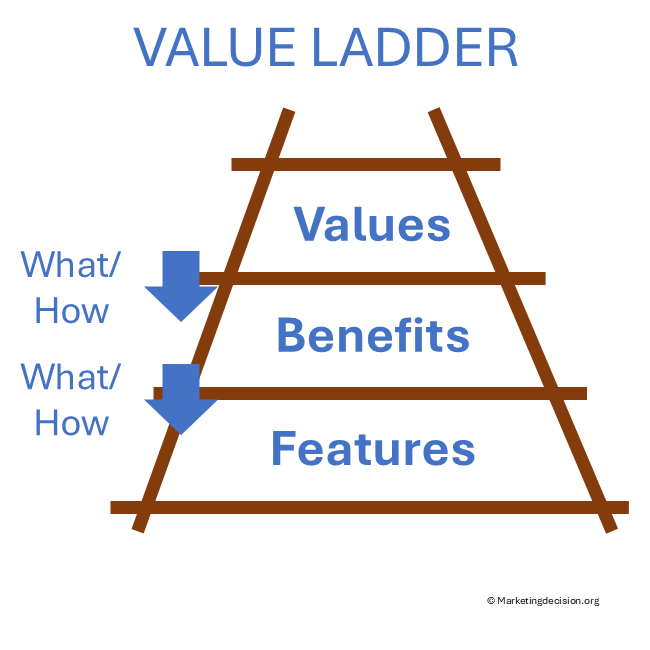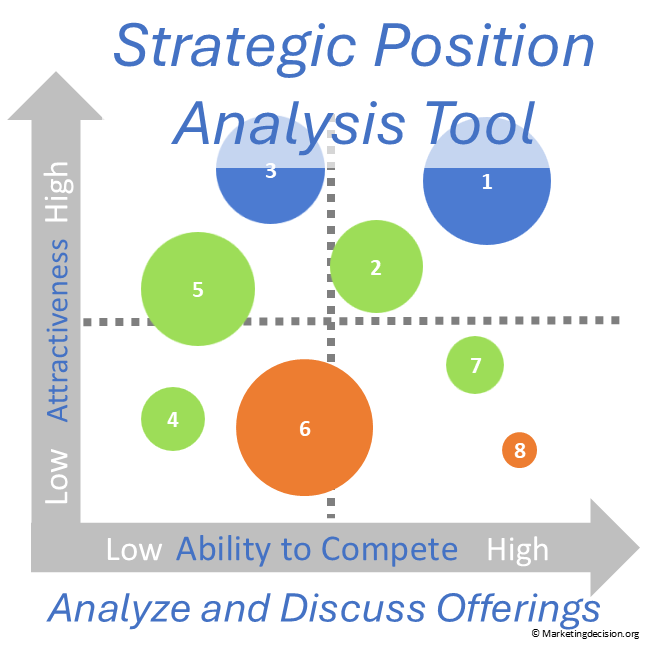Description
This product offers a method for engaging teams and assessing the benefit ladder. The method is described in detail within a PDF document.
The Value Ladder, also known as the Benefit Ladder, is a tool that can be described in various ways online. Some descriptions focus more on communication, while others emphasize value creation and solution positioning. The latter are the main objectives discussed in here.
In sales and marketing, a key practice is asking what is important to a customer and why. Answers will vary from person to person and can generally be divided into three categories:
Features: These are product characteristics that can usually be measured and quantified.
Benefits: These are the results of those features and how they affect the customer experience.
Values: These are the customer values fulfilled by delivering those benefits.
To connect these categories, the key is asking “why.” When you ask why a feature is important, you uncover the benefits. Similarly, asking why those benefits matter reveals the values important to your customers. This process allows you to climb the ladder. Conversely, by asking “what” and “how,” you can descend the ladder.
This tool effectively connects features and values in both directions. For example, when considering a customer market segment with known values, it helps identify the features required to deliver the desired benefits. Likewise, starting from features, you can link them to benefits and values to see which customer segments are best addressed by those features.
Why Use the Value Ladder?
The Value Ladder bridges the gap between customer values and solution features. It is essential for assessing and comparing solutions across different customer segments. Moreover, it helps you compare solutions against each other while considering customer needs and behaviors. This makes it a critical tool for future solution development.
Climbing the Ladder – Assessing Adequacy for Customer Segments
Starting with an existing solution and climbing the ladder is a great way to build it for the first time. This approach is natural and intuitive because asking “why” is straightforward. Since values are typically not numerous, features can often be grouped by their benefit impacts, which simplifies the process of climbing the ladder.
By developing the ladder for your company’s solutions and also analyzing competitors’ offerings, you can better understand how well solutions align with customer segments. You might find that certain features are unnecessary for specific segments, adding unnecessary costs or complications. On the other hand, you may also identify features that are critical for addressing certain market segments.
Descending the Ladder – Identifying Differentiating Features to Create Customer Value
Developing the Value Ladder for each customer segment helps you identify features that will differentiate your solution and optimize it for specific segments. Many believe that what works for the most demanding segments will work for all. However, this approach can lead teams to focus too much on a few high-demand segments while overlooking the broader customer base.
Instead, developing a range of solutions, possibly with optional features, can address various target segments more effectively.
Benefits of Using the Value Ladder
There are several key benefits to using the Value Ladder:
Improved Clarity: It clarifies customer segment values versus the benefits and features delivered, leading to better-targeted communication.
Competitiveness: It enhances understanding of competitiveness across company and competitor solutions.
Feature Prioritization: It helps prioritize features and benefits to increase competitiveness or address new customer segment needs.
Solution Configuration: It provides insights into organizing solution configurations, including optional features.
Pricing: It helps with pricing by understanding customer-perceived value for certain features, explaining why some customers are willing to pay for them while others are not.
Further Reading and Tips
This approach is similar to the Quality Function Deployment (QFD) methodology, which connects customer needs to product characteristics. Conjoint analysis also identifies value from product characteristics and how they are perceived by different customer segments. For more information, you can refer to the Wikipedia article on QFD here.
https://en.wikipedia.org/wiki/Quality_function_deployment
When searching for the Benefit Ladder online, you may find that the top level is often labeled “emotional benefits.” Translating values into emotions is a useful way to understand customer perspectives during key moments, such as during a purchase or when using a solution. This approach can improve communication and branding while maintaining a focus on values. You can read more about this in the article here.
https://medium.com/@snooner15/the-rethink-the-bad-religion-of-the-brand-benefit-ladder-e5513a0cae13
However, it is important not to focus solely on communication or branding when using the Benefit Ladder. There is much more to this tool than just considering customer emotions.
A valuable exercise for marketing teams is to consider the Value Ladder for different segments. Divide a large team into smaller groups of about five people, and have them discuss the Value Ladder for a specific segment. Make sure the segment is well-defined and provide examples of customers. Involving salespeople to bring their own examples is also useful. This exercise has many benefits, such as identifying customers who fit into certain segments, describing potential pitfalls, and suggesting sales strategies to better align with customer needs.
Value Ladder Deployment
When mapping customer segment values to solution benefits and features, it is recommended to use a single page to map the three categories: Values, Benefits, and Features. This process can be done by customer segment or by solution. For customer segments, the outcome will list benefits and features that align with the values of that segment. It also compares solutions (both company and competitor) that best meet these objectives, and identifies which features impact product positioning the most. In short, this helps determine the ideal future solution for each market segment.
In Summary
The Value Ladder is a key tool for mapping customer values to benefits and features. It is an effective method for understanding why certain solutions meet customer needs and how to develop new features and capabilities to boost competitiveness by optimizing solution offerings.
Usage & Licensing
Please review the Sales Conditions published on this website to fully understand your rights and the restrictions regarding the use of this product. Our products are intended for professional use only and are not designed for consumer purposes.
The products provided under this agreement are exclusively for the individual buyer or members of the same business unit. Sharing, distributing, or making them available to individuals or teams outside the designated user or relevant business unit is strictly prohibited. For software licensing purposes, a business unit is limited to a maximum of 100 employees, including full-time, part-time, and temporary staff. Additional licenses must be purchased in multiples of 100 if this limit is exceeded.
The provided download link is valid for two months and allows up to 10 downloads. Be sure to save a copy before the link expires or the download limit is reached. Users have full access to the application product, including any embedded macros, and may make necessary adjustments to suit their needs. However, all branding, trademarks, and references to marketingdecision.org must remain visible and intact within the application.
We appreciate your feedback on how to improve this application. Feel free to share your suggestions with us at contact@marketingdecision.org

